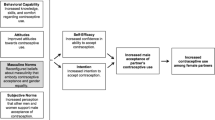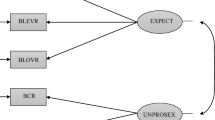Abstract
Adolescents’ sexual decision making is shaped by normative ideas about “appropriate” sexual roles for women and men; consequently, the motivation and ability to engage in safer sex may be different for adolescent girls and boys. The aim of this study was to explore how social–psychological resources influence the behavior of girls and boys within the highly gendered and inequitable domain of sexual relationships. I used data from the National Longitudinal Study of Adolescent Health (Add Health) to examine whether personal control and self-efficacy in sexual negotiation are associated with contraceptive risk (engaging in sexual intercourse or not using condoms) among adolescents and whether these associations differ for adolescent boys and girls. Results indicate that personal control and self-efficacy in sexual negotiation are significantly associated with safer sex behavior, and are often more important for girls than for boys in predicting contraceptive risk.


Similar content being viewed by others
References
Alan Guttmacher Institute (1999). Facts in brief: Teen sex and pregnancy. Retrieved July 13, 2005, from http://www.agi-usa.org/pubs/fb_teen_sex.
Amaro, H. (1995). Love, sex, and power: Considering women’s realities in HIV prevention. American Psychologist, 30, 437–447.
Bandura, A. (2001). Social cognitive theory: An agentic perspective. Annual Review of Psychology, 52, 1–26.
Bandura, A. (2004). Health promotion by social cognitive means. Health Education & Behavior, 31, 143–164.
Bowleg, L., Belgrave, F. Z., & Reisen, C. A. (2000). Gender roles, power strategies, and precautionary sexual self-efficacy: Implications for Black and Latina women’s HIV/AIDS protective behaviors. Sex Roles, 42, 613–635.
Brien, T. M., & Thombs, D. L. (1994). Dimensions of self-efficacy among three distinct groups of condom users. Journal of American College Health, 42, 167–174.
Campbell, C. A. (1995). Male gender roles and sexuality: Implications for women’s AIDS risk and prevention. Social Science and Medicine, 41, 197–210.
De Gaston, J. F., Jensen, L., & Weed, S. (1995). A closer look at adolescent sexual activity. Journal of Youth and Adolescence, 24, 465–479.
De Gaston, J. F., Weed, S., & Jensen, L. (1996). Understanding gender differences in adolescent sexuality. Adolescence, 31, 217–231.
Furstenberg, F. F. Jr., Morgan, S. P., Moore, K. A., & Peterson, J. L. (1987). Race differences in the timing of adolescent intercourse. American Sociological Review, 52, 511–518.
Gavey, N., McPhillips, K., & Doherty, M. (2001). “If it’s not on, it’s not on”—Or is it? Discursive constraints on women’s condom use. Gender & Society, 15, 917–934.
Gecas, V. (1989). The social psychology of self-efficacy. Annual Review of Sociology, 15, 291–316.
Goh, D. S., Primavera, C., & Bartalini, G. (1996). Risk behaviors, self-efficacy, and AIDS prevention among adolescents. Journal of Psychology, 130, 537–546.
Gomez, C. A., & Marin, B. V. (1996). Gender, culture, and power: Barriers to HIV-prevention strategies for women. Journal of Sex Research, 33, 355–362.
Gutierrez, L., Oh, H. J., & Gillmore, M. R. (2000). Toward an understanding of (em)power(ment) for HIV/AIDS prevention with adolescent women. Sex Roles, 42, 581–611.
Kahn, J. R., Rindfuss, R. R., & Guilkey, D. K. (1990). Adolescent contraceptive method choices. Demography, 27, 323–335.
Kaplan, E. B. (1997). Not our kind of girl: Unraveling the myths of Black teenage motherhood. Berkeley, California: University of California.
Levinson, R. A. (1986). Contraceptive self-efficacy: A perspective on teenage girls’ contraceptive behavior. Journal of Sex Research, 22, 347–369.
Levinson, R. A. (1995). Reproductive and contraceptive knowledge, contraceptive self-efficacy, and contraceptive behavior among teenage women. Adolescence, 30, 65–85.
Levinson, R. A., Wan, C. K., & Beamer, L. J. (1998). The contraceptive self-efficacy scale: Analysis in four samples. Journal of Youth and Adolescence, 27, 773–793.
Lewis, S. K., Ross, C. E., & Mirowsky, J. (1999). Establishing a sense of personal control in the transition to adulthood. Social Forces, 77, 1559–1573.
Luker, K. (1996). Dubious conceptions: The politics of teenage pregnancy. Cambridge, Massachusetts: Harvard University Press.
Marsiglio, W. (1993). Adolescent males’ orientation toward paternity and contraception. Family Planning Perspectives, 25, 22–31.
Martin, K. A. (1996). Puberty, sexuality, and the self: Boys and girls at adolescence. New York: Routledge.
Mirowsky, J., & Ross, C. E. (1983). Paranoia and the structure of powerlessness. American Sociological Review, 48, 228–239.
Mirowsky, J., & Ross, C. E. (2003a). Social causes of psychological distress. New York: Aldine De Gruyter.
Mirowsky, J., & Ross, C. E. (2003b). Education, social status, and health. New York: Aldine de Gruyter.
Moore, S., & Rosenthal, D. (1993). Sexuality in adolescence. London: Routledge.
National Center for HIV, STD, and TB Protection (2001). Tracking the hidden epidemics: Trends in STDs in the United States 2000. Retrieved July 13, 2005, from http://www.cdc.gov/nchstp/dstd/Stats_Trends/Trends2000.pdf.
Phillips, L. M. (2000). Flirting with danger: Young women’s reflections on sexuality and domination. New York: New York University Press.
Pleck, J. H., Sonenstein, F. L., & Ku, L. C. (1990). Contraceptive attitudes and intention to use condoms in sexually experienced and inexperienced adolescent males. Journal of Family Issues, 11, 294–312.
Pleck, J. H., Sonenstein, F. L., & Ku, L. C. (1993). Masculinity ideology: Its impact on adolescent males’ heterosexual relationships. Journal of Social Issues, 49, 11–29.
Ross, C. E., & Mirowsky, J. (1989). Explaining the social patterns of depression: Control and problem-solving or support and talking? Journal of Health and Social Behavior, 30, 206–219.
Ross, C. E., & Sastry, J. (1999). The sense of personal control: Social-structural causes and emotional consequences. In C. S. Aneshensel & J. C. Phelan (Eds.), Handbook of the sociology of mental health (pp. 369–394). New York: Kluwer.
Santelli, J. S., Lindberg, L. D., Abma, J., McNeely, C. S., & Resnick, M. (2000). Adolescent sexual behavior: Estimates and trends from four nationally representative surveys. Family Planning Perspectives, 32, 156–165,194.
Seeman, M., & Seeman, T. E. (1983). Health behavior and personal autonomy: A longitudinal study of the sense of control in illness. Journal of Health and Social Behavior, 24, 144–160.
Soler, H., Quadagno, D., Sly, D. F., Riehman, K. S., Eberstein, I. W., & Harrison, D. F. (2000). Relationship dynamics, ethnicity, and condom use among low-income women. Family Planning Perspectives, 32, 82–88,101.
Steers, W. N., Elliott, E., Nemiro, J., Ditman, D., & Oskamp, S. (1996). Health beliefs as predictors of HIV-preventive behavior and ethnic differences in prediction. Journal of Social Psychology, 136, 99–110.
Terry, E., & Manlove, J. (2000). Trends in sexual activity and contraceptive use among teens. Washington, District of Columbia: Child Trends.
Thoits, P. A. (1987). Gender and marital status differences in control and distress: Common stress versus unique stress explanations. Journal of Health and Social Behavior, 28, 7–22.
Thomson, R., & Holland, J. (1998). Sexual relationships, negotiation, and decision making. In J. Coleman & D. Roker (Eds.), Teenage sexuality: Health, risk, and education (pp. 59–80). Amsterdam: Harwood.
Tolman, D. L. (1994). Doing desire: Adolescent girls’ struggles for/with sexuality. Gender & Society, 8, 324–342.
Tschann, J. M., Adler, N. E., Millstein, S. G., Gurvey, J. E., & Ellen, J. M. (2002). Relative power between sexual partners and condom use among adolescents. Journal of Adolescent Health, 31, 17–25.
Udry, J. R. (2003). The national longitudinal study of adolescent health (Add Health), waves I & II, 1994–1996; wave III, 2001–2002 [machine-readable data file and documentation] Chapel Hill, North Carolina: Carolina Population Center, University of North Carolina at Chapel Hill.
Umberson, D. (1993). Sociodemographic position, world views, and psychological distress. Social Science Quarterly, 74, 575–589.
Umberson, D., Anderson, K., Glick, J., & Shapiro, A. (1998). Domestic violence, personal control, and gender. Journal of Marriage and the Family, 60, 442–452.
Wheaton, B. (1980). The sociogenesis of psychological disorder: An attributional theory. Journal of Health and Social Behavior, 21, 100–124.
Acknowledgments
The author would like to thank Chandra Muller and Debra Umberson for their comments on previous drafts of this article. The author would also like to thank the members of the Adolescent Health and Academic Achievement project for their comments and suggestions. The author accepts full responsibility for any shortcomings of this research.
Author information
Authors and Affiliations
Corresponding author
Additional information
This research was funded by grants from the National Institute of Child Health and Human Development under grant R01 HD40428-02 to the Population Research Center, University of Texas at Austin, Chandra Muller (PI), and from the National Science Foundation under grant REC-0126167 to the Population Research Center, University of Texas at Austin, Chandra Muller (PI). This research is based on data from the Add Health project, a program project designed by J. Richard Udry (PI) and Peter Bearman, and funded by grant P01-HD31921 from the National Institute of Child Health and Human Development to the Carolina Population Center, University of North Carolina at Chapel Hill. Persons interested in obtaining data files from Add Health should contact Add Health, Carolina Population Center, 123 W. Franklin Street, Chapel Hill, NC 27516-2524 (addhealth@unc.edu). Opinions reflect those of the author and do not necessarily reflect those of the granting agencies.
Appendix
Appendix
Descriptive Statistics for the Full Add Health Sample and Analytical Samples (Unweighted)
| Mean or Proportion (Standard Deviation) | ||
Full Add Health sample | Sexual intercourse sample | Condom use sample | |
Sex/gender | |||
Boys | .495 | .488 | .500 |
Girls | .505 | .512 | .500 |
Racial/ethnic identity | |||
Non-Latino/ a White | .504 | .506 | .481 |
Non-Latino/ a Black | .225 | .201 | .259 |
Latino/a | .170 | .187 | .184 |
Asian | .071 | .079 | .047 |
Other | .030 | .027 | .030 |
Age | 16.165 (1.723) | 16.679 (1.023) | 16.870 (1.023) |
Time between interviews | 10.950 (1.757) | 10.981 (1.693) | 11.071 (1.661) |
Socioeconomic status | |||
Family income | 45.926(44.403) | 46.982 (49.128) | 43.341 (34.709) |
Parent’s education | 2.835 (1.258) | 2.840 (1.278) | 2.711 (1.208) |
N | 20,745 | 8,589 | 3,572 |
Rights and permissions
About this article
Cite this article
Pearson, J. Personal Control, Self-Efficacy in Sexual Negotiation, and Contraceptive Risk among Adolescents: The Role of Gender. Sex Roles 54, 615–625 (2006). https://doi.org/10.1007/s11199-006-9028-9
Published:
Issue Date:
DOI: https://doi.org/10.1007/s11199-006-9028-9




